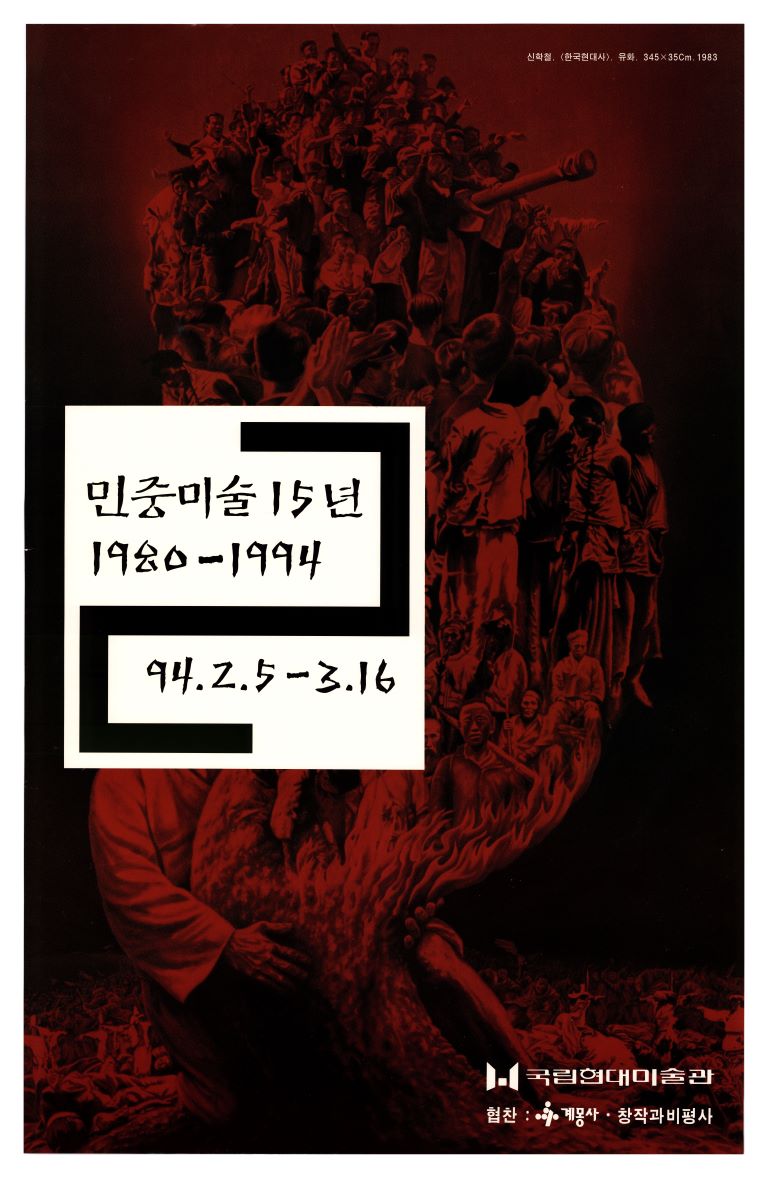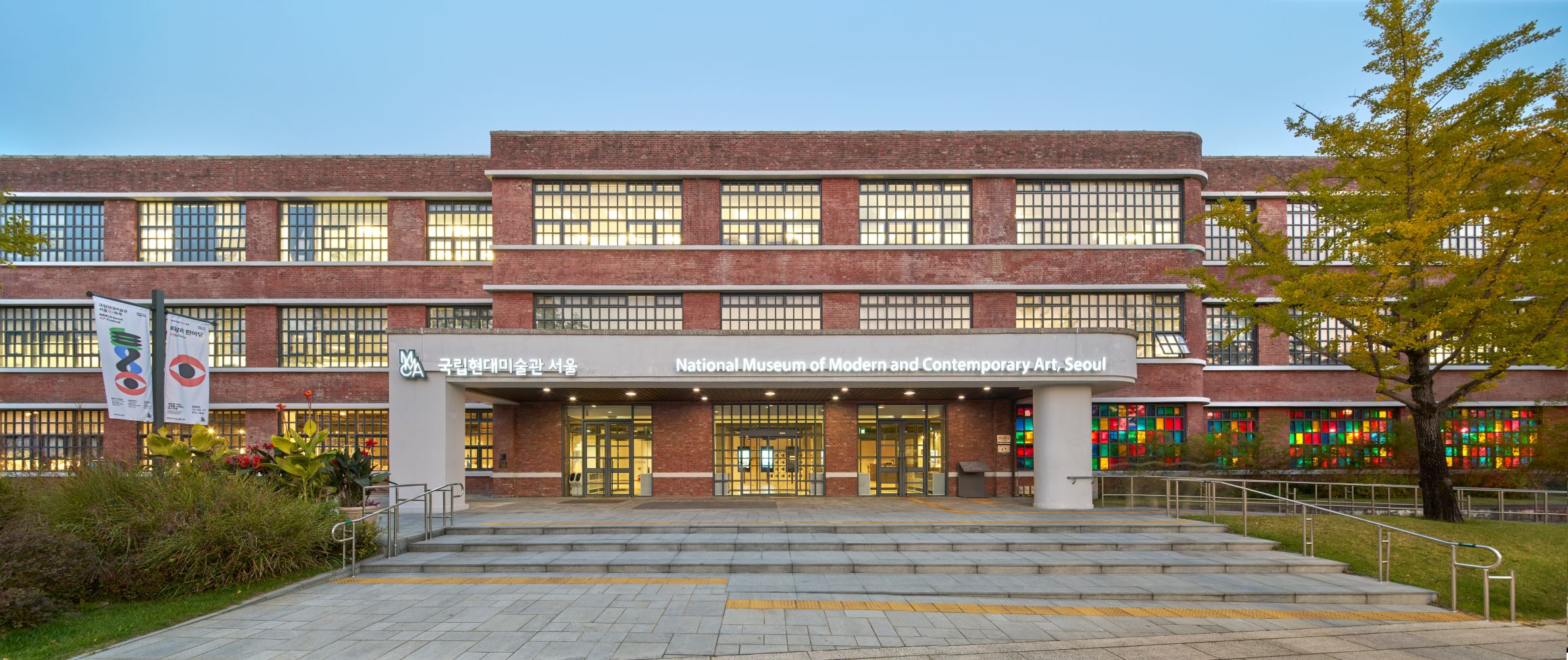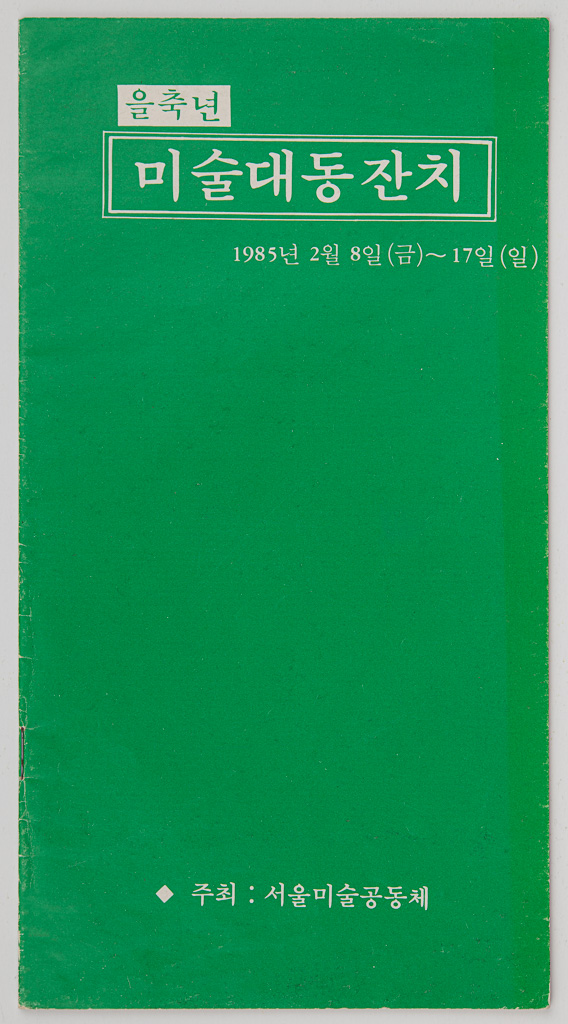
15 Years of Korean Minjoong Arts: 1980-1994, Exhibition poster, MMCA Art Research Center Collection
15 Years of Korean Minjoong Arts: 1980-1994
* Source: Multilingual Glossary of Korean Art. Korea Arts Management Service
Related
-

National Museum of Modern and Contemporary Art, Korea (MMCA)
A national museum established in 1969 that researches, collects, and exhibits modern and contemporary art. As of 2018, there are branches in Gwacheon, Deoksugung, Seoul, and Cheongju. When first established, the National Museum of Modern Art (now MMCA) was located within Gyeongbokgung palace. In 1973, the museum moved to the East Wing of the Deoksugung Seokjojeon building. Then, in 1986, the museum moved to its current location in Gwacheon, to occupy a new building equipped with an outdoor sculpture exhibition space, and has since opened a new chapter in Korean art. The perceived need for a space to focus specifically on Korean contemporary art led to the establishment of further site, the National Museum of Contemporary Art, Deoksugung in 1998. In November 2013, a further demand for contemporary art exhibitions led to the establishment of another Seoul branch being created in the Defense Security Command building in Sogyeok-dong, Jongno-gu, which has since its inception engaged in multifaceted exhibitions of both domestic and overseas contemporary art. Also, as a further component of the MMCA complex, a disused tobacco factory in Cheongju was remodeled to provide a home to the National Art Storage Center.
-

Minjung Art
An artistic movement that came to prominence alongside Korea’s democratization movement in the 1980s. Minjung artists often sought to critically portray the violent repression and corruption of the military dictatorship, to represent the experiences of laborers and farmers, and to achieve social change through art. In contrast to abstraction, which constituted the mainstream of 1970s art in Korea, Minjung Art is notable for the use of representational and figurative forms. One possible point of origin for Minjung Art is Oh Yoon’s work in the Reality Group (Hyeonsil dongin). The group was formed in 1969 by Kim Ji-ha, Oh Yoon, and Lim Se-taek. A variety of Minjung art groups were established, including the Reality and Utterance (Hyunsilgwa bareon) in 1979 by Kim Jungheun, Oh Yoon, Joo Jae-hwan, art critic Sung Wan-kyung, and Choi Min, the Gwangju Freedom Artist Association (Gwangju jayu misulin hyeopuihoe) in 1979 by Hong Sungdam and Choi Youl, the Imsulnyeon (The Year Imsul) in 1982, and the Dureong in 1983. These groups all commonly critiqued Western capitalism. In terms of form, Minjung artists adopted traditional and ethnic folk modes of expression using diverse media such as collage, printmaking, oil painting, and photography. Following the 15 Years of Korean Minjoong Arts: 1980-1994 Exhibition at the National Museum of Modern and Contemporary Art, Minjung Art became an accepted part of Korean art history. Overseas, Minjung Art has also become a recognized term that describes this genre and its unique focus on the political and social history of Korea.
Find More
-

Seoul Art Coalition
The Seoul Art Coalition (SAC) was a solidarity community of small groups in the Seoul area that was formed in 1984 and was active until 1987. From October 1 to 3 in 1983, the “Three Days and Three Nights Discussion” was held in Daeseong-ri, Gapyeong, Gyeonggi-do Province. At the time, Ok Bonghwan, Kim Bongjun, Moon Youngtae, Chang Jinyoung, Choi Minhwa, Choi Youl, Hong Seonwung, and Hong Sungdam gathered to discuss the nature, direction, and challenges of an art movement. They decided to promote an art movement based on solidarity. It was agreed that each region would form an “art community” based not on the critical realism of “Reality and Utterance” but on folk realism. The idea was to form art communities in Seoul, Gwangju, Busan, Incheon, Jeju, and other regions and grow them into a national organization. Choi Minhwa immediately discussed the concept of an art coalition with Yoo Yeunbok and Park Jinhwa. Choi was designated as the person in charge of cartoons, Yoo Yeunbok for mural paintings, and Lee Ki-jung for prints. From January 1984, the SAC began hosting open forums to restore and build a healthy art. It compiled materials and printed 200 copies of Hyeondae misul (Contemporary art). In June of the same year, its members participated in Life Portrayed by 105 Artist, and in September they held an inaugural meeting for the “art coalition” and elected Choi Minhwa as the first director of planning. In October, the SAC published a print calendar Poems and Woodcut Calendars (Woorimadang). The SAC was officially launched in February 1985. The small groups that joined the SAC include Silcheon (Geurim dongin Silcheon), Hoengdan, Namu [Mokpan moin namu], Espa, the Committee of Sidaejeongsin(Zeitgeist) [Sidae jeongsin gihoek wiwonhoe], Mural Painting Organization Sipjangsaeng [Byeokhwa giheok sipjangsang], and Uksae. Its purpose was to “creatively develop the rich formal values of visual arts, fight against any factors that restrict free expression, and seek ways for artworks to be committed to the lives of people.” Simultaneously with its launching, the SAC held art fairs for the populace, such as Eulchuknyeon Group Art Festival and the Gangnam Art Market. In April, it published its bulletin Misul gongdongche (Art community). The publication continued until 1986 with a total of five volumes. In May, the SAC created and posted a hanging painting at the May Third Incheon Laborers Conference. In June, the first general assembly was held, and Son Kihwan was elected as the second director of planning. In July, Son Kiwhan, Park Jinhwa, and Park Buldong curated the exhibition Power of the Art by the Twenties but the police arrested the artists and confiscated their works. In February 1986, the Byeonginnyeon Group Art Festival was held at the Arab Art Museum. At the second general assembly in March, Yoo Yeunbok was elected as the third director of planning, and at the third general assembly in 1987, Park Jinhwa was elected as the fourth director of planning. On June 17, 1986, the SAC painted the mural Joy of Unification on the building in front of Sinchon Station, and on July 26, it did the mural Co-Living on the wall of Yoo Yeunbok’s house. These two murals were defaced by the state. Those who created the latter, including Yoo Yeunbok, Kim Jinha, Choi Byungsoo, Hong Hwanggi, and Kim Yongman, were indicted without detention. The SAC organized the exhibition Satire and Humor in August and the exhibition Art and Politics at Great Transition, in November 1987. In January 1988, the SAC members discussed its dissolution at a restaurant in Insa-dong and then disbanded. The SAC is the first collective of small groups that was formed after the agreement on turning the national organizations of Minjung art movement into art communities was made. They accomplished significant achievements in the popular art movement, mural movement, and art discourse.
-

Sidaejeongsin (Zeitgeist)
Sidaejeongsin (Zeitgeist) is the first collective group formed in 1983 and remained active until 1987. In the early spring of 1983, Kim Hyeonsu, the director of the Third Museum of Art, asked Park Geon to curate an exhibition to make used of the cancelled exhibition period. Together with Moon Youngtae, Park Geon formed the Committee of Sidaejeongsin and tried a collective that gathered for exhibitions and publications and then dispersed. Moon oversaw organizing exhibitions, and Park assumed the task of publications. Moon and Park first met in April 1980 when Moon visited Park’s exhibition Strength in Busan. The two became close when Park came to Seoul and participated in exhibitions Young Minds and Traverse. Their goal was to weave together the sporadic small art movements of the early 1980s with a larger “cultural force.” Their intentions can be found in the following sentence printed in small letters on the cover of the mook (magazine-book) Sidaejeongsin: “’life’ to run toward from all directions; touch, pinch and embrace.” Park Geon stated that the spirit of an artist who sees through the times is "Zeitgeist.” In the preface of the first volume of Sidaejeongsin (Zeitgeist), the art critic Kim Yoon-Soo explained that “sidaejeongsin (zeitgeist) comes from the insight and recognition that the spirit making up our lives today is indeed in a state of corruption and irreversibility” and that “zeitgeist is the awakened spirit leading national history against all the phenomena, mindsets, institutions, and systems, all of which prevent all human beings from living a dignified life.” The first Sidaejeongsin exhibition was held in April 1983 at the Third Museum of Art. The fourteen artists who participated in the exhibition were Kang Yobae, Ko Kyeong-hun, Kim Bojung, Kim Jinyeol, Moon Youngtae, Park Geon, Park Jae-dong, Ahn Changhong, Yun Yeogeol, Lee Nagyeong, Lee Chulsoo, Lee Taeho, Jung Bocsu, and Choi Minhwa. Park Geon, who had edited textbooks at a university, edited and published the first volume of the mook Sidae jeongsin, which also served as an exhibition catalogue, in 1984. From then on, the group name, exhibition name, and mook name were collectively referred to as “Sidaejeongsin.” By 1987, they had organized a total of five exhibitions and published three volumes of the Sidaejeongsin. The theme of the first volume was “The Vitality of the Minjung Art Movement,” that of the second volume was “The Aesthetics of Liberation: Murals, Photography, Prints, and Cartoons,” and that of the third volume was “Sexuality in Our Time.” The second edition of the Sidaejeongsin exhibition traveled to Maek Gallery (Busan), Ijo Gallery (Masan), and Maekhyang Gallery (Daegu). The third edition was a print exhibition organized in collaboration with the Art School for Citizens. The fourth edition was held at Min Art Gallery, and the fifth edition was held on the theme of “what do our children draw” at the same place. In 1985, the National Art Association (Minjok misul hyeopuihoe) was established. As it published its bulletin in 1986 and Min Art Gallery, an exhibition space specializing in Minjung art was established, the Committee of Sidaejeongsin concluded its activities with the fifth exhibition. Afterwards, Moon Youngtae devoted himself to the activities of the National Art Association, and Park Geon engaged himself in the activities of the National Teachers’ Council for Democratic Education Promotion [Minju gyoyuk chujin jeonguk gyosa hyeopuihoe].
-

Dureong
Dureong was an art group founded in 1982 primarily comprised of Hongik University alumni that emphasized the ideology of Minjung Art. The group particularly rejected the use of Western methods and individualism that were adopted by the art group Reality and Utterance [Hyunsilgwa bareon]. Instead, they sought to create ethnically Korean, contemporary grass-roots art and develop more populist methods of expression. They aimed to create art that was relevant to the everyday lives of contemporary people rather than “nihilistic and commercialized sick paintings.” Their name originated from their periodicals Live Paintings and Live Art. The Dureong focused on ordinary people to foster art work based on everyday lives with the aim to educate people’s cultural sensibility. They also conducted research into traditional folk art, which they assumed as the origin of Korean Minjung art, and inherited the legacy of this work, in terms of trying to produce an art history relevant to ordinary people. They also emphasized collaborative projects as a means to democratize art production. The group engaged in joint projects for grassroots art, the creation of murals and prints, and ethnically grounded Korean art education until 1987.






